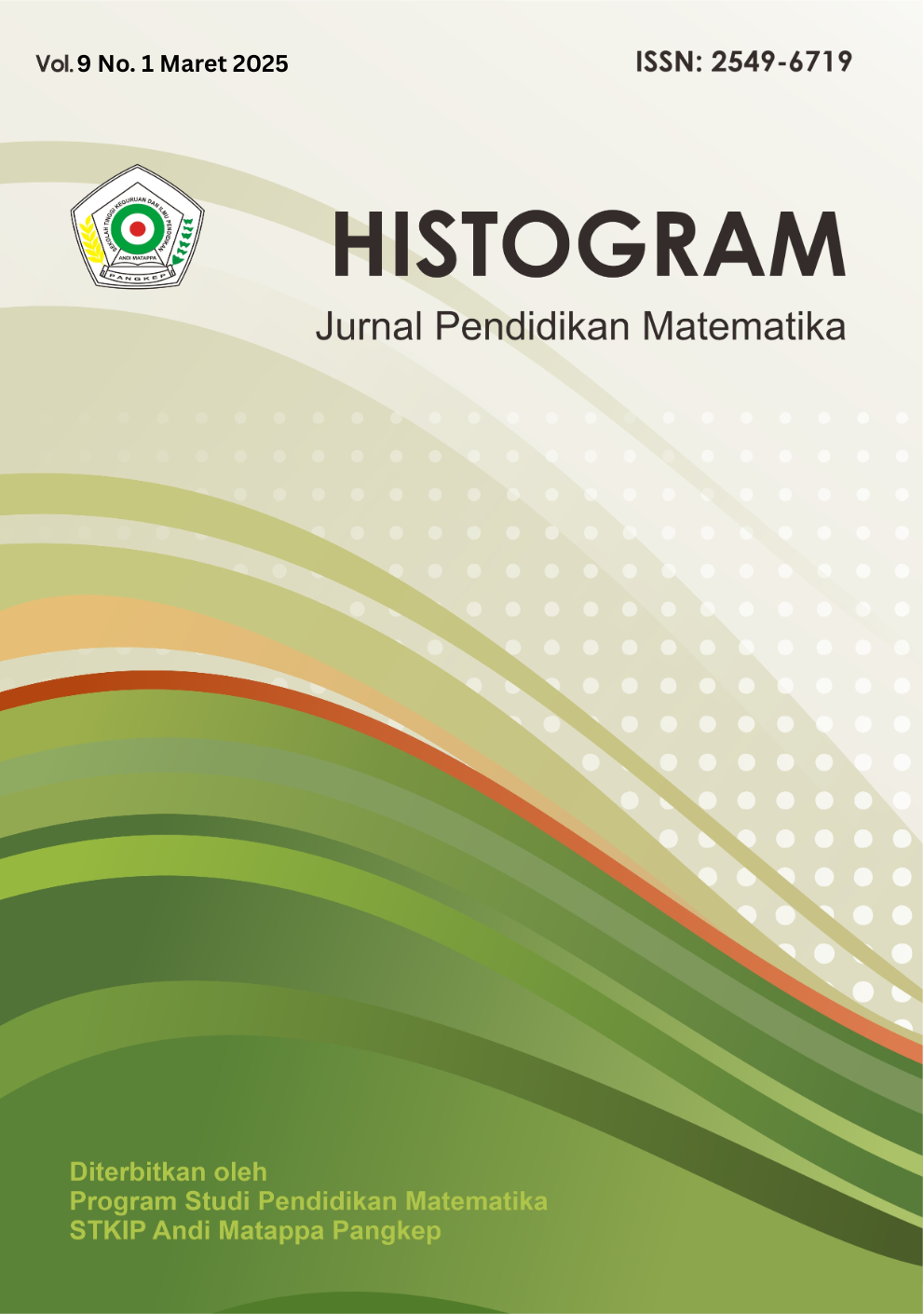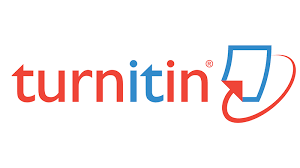MENINGKATKAN PEMAHAMAN KONSEP LUAS BANGUN DATAR MELALUI PENDEKATAN HLT BERBASIS RME
DOI:
https://doi.org/10.31100/histogram.v9i1.4094Keywords:
Hypothetical Learning Trajectory, Realistic Mathematics Education, Area of Plane FiguresAbstract
ABSTRAK
Proses pembelajaran matematika kerap menghadapi berbagai kendala, seperti keterbatasan pemahaman guru terhadap pendekatan Hypothetical Learning Trajectory (HLT) dan Realistic Mathematics Education (RME), kurangnya media pembelajaran yang memadai, serta perbedaan kemampuan siswa di dalam kelas. Penelitian ini bertujuan untuk meningkatkan pemahaman konsep luas bangun datar melalui penerapan pendekatan HLT yang berlandaskan RME. Metode penelitian yang digunakan adalah Penelitian Tindakan Kelas (PTK) yang dilaksanakan dalam tiga siklus, meliputi tahap perencanaan, pelaksanaan, observasi, dan refleksi. Subjek penelitian terdiri atas siswa kelas VII SMP Muhammadiyah 07 Sukaraja. Data dikumpulkan melalui tes hasil belajar, observasi, angket siswa, dan dokumentasi. Hasil penelitian menunjukkan bahwa penerapan pendekatan HLT berbasis RME mampu meningkatkan pemahaman siswa terhadap konsep luas bangun datar. Tingkat ketuntasan belajar meningkat dari 50% pada siklus I, menjadi 76,67% pada siklus II, dan mencapai 100% pada siklus III. Dengan demikian, pendekatan HLT berbasis RME terbukti efektif dalam meningkatkan pemahaman konsep luas bangun datar siswa.
ABSTRACT
The mathematics learning process often faces several challenges, such as teachers’ limited understanding of the Hypothetical Learning Trajectory (HLT) and Realistic Mathematics Education (RME) approaches, insufficient learning media, and the diverse abilities of students. This study aims to improve students’ understanding of plane figures through the application of the HLT approach based on RME. The research method used was Classroom Action Research (CAR), conducted in three cycles, each consisting of planning, implementation, observation, and reflection stages. The research subjects were seventh-grade students of SMP Muhammadiyah 07 Sukaraja. Data were collected through learning outcome tests, observations, student questionnaires, and documentation. The results showed that the HLT-based RME approach effectively enhanced students’ understanding of the concept of the area of plane figures. The percentage of students achieving mastery increased from 50% in the first cycle to 76.67% in the second cycle, and reached 100% in the third cycle. Therefore, the HLT-based RME approach proved to be effective in improving students’ conceptual understanding of the area of plane figures.
References
Aklimawati, A., Listiana, Y., Isfayani, E., Zainuddin, Z., & Aulia, R. (2022). Pengembangan Hypothetical Learning Trajectory (HLT) Berbasis Realistic Mathematics Education (RME) pada Materi Geometri. Jurnal Serunai Matematika, 14(2), 51–63. https://doi.org/10.37755/jsm.v14i2.665
Aminullah, A., & Irwansya, I. (2024). Analisis Efektivitas Penggunaan Teknologi dalam Pembelajaran Matematika. Jago MIPA: Jurnal Pendidikan Matematika dan IPA, 4(4), 678–687. https://doi.org/10.53299/jagomipav4i4.721
Apriyanti, E., Asrin, A., & Fauzi, A. (2023). Model Pembelajaran Realistic Mathematics Education dalam Meningkatkan Pemahaman Konsep Matematika Siswa Sekolah Dasar. Jurnal Educatio, 9(4), 1978–1986. https://doi.org/10.31949/educatio.v9i4.5940
Asmara, A. S., Fitri, A., & Faizah, N. L. (2022). Analisis Kemampuan Pemahaman Konsep Matematis pada Materi Bangun Datar di Kelas IV Sekolah Dasar. Jurnal Sekolah Dasar, 7(2), 173–188. https://doi.org/10.36805/jurnalsekolahdasar.v7i2.2953
Asyamsi, M. R., Sudadio, S., & Fauzi, A. (2025). Pemanfaatan Media Pembelajaran Interaktif untuk Meningkatkan Motivasi Warga Belajar. Jurnal Niara, 17(3), 239–246. https://doi.org/10.31849/niara.v17i3.21125
Deciku, B., Musdi, E., Arnawa, I. M., & Suherman, S. (2022). Hypothetical Learning Trajectory Sistem Persamaan Linear Dua Variabel dengan Pendekatan Realistic Mathematics Education. Jurnal Cendekia: Jurnal Pendidikan Matematika, 7(1), 185–196. https://doi.org/10.31004/cendekia.v7i1.1781
Hadila, R., Sukirwan, S., & Alamsyah, T. P. (2020). Desain Pembelajaran Bangun Datar melalui Pendekatan Realistic Mathematics Education (RME). GAUSS: Jurnal Pendidikan Matematika, 3(1), 49–63. https://doi.org/10.30656/gauss.v3i1.2172
Handayani, P. V., Sukayasa, S., Ismaimuza, D., & Meinarni, W. (2024). Pemahaman Konsep Siswa dalam Menyelesaikan Soal Kubus Ditinjau dari Level Van Hiele. Histogram: Jurnal Pendidikan Matematika, 8(1), 113–126. https://doi.org/10.31100/histogram.v8i1.3448
Hidayati, I., Deciku, B., & Azizah, T. (2022). Hypothetical Learning Trajectory Sistem Persamaan Linear Dua Variabel Berbasis Realistic Mathematics Education. Juring (Journal for Research in Mathematics Learning), 5(2), 109–118. https://doi.org/10.24014/juring.v5i2.14933
Leuwol, F. S., Basiran, B., Solehuddin, M., Vanchapo, A. R., Sartipa, D., & Munisah, E. (2023). Efektivitas Metode Pembelajaran Berbasis Teknologi terhadap Peningkatan Motivasi Belajar Siswa di Sekolah. Edusaintek: Jurnal Pendidikan, Sains dan Teknologi, 10(3), 988–999. https://doi.org/10.47668/edusaintek.v10i3.899
Meilani, M., Kamariah, S., & Yuliana, R. (2022). Analisis Kemampuan Pemahaman Matematis Siswa terhadap Materi Bangun Datar Kelas VII. Jurnal Jendela Pendidikan, 2(2), 295–302. https://doi.org/10.57008/jjp.v2i02.210
Mone, P. S., Nenohai, J. M. H., & Samo, D. d. (2022). Kemampuan Koneksi Matematis Siswa dalam Pembelajaran Matematika di Tingkat SMP. Fraktal: Jurnal Matematika dan Pendidikan Matematika, 3(1), 12–24. https://doi.org/10.35508/fractal.v3i1.5602
Mulyono, M., Slamet, S. Y., & Chumdari, C. (2025). The Impact of the Use of Interactive Learning Media on Understanding the Concept of the Food Chain. Social, Humanities, and Educational Studies SHEs: Conference Series, 8(1), 196 – 207. https://doi.org/10.20961/shes.v8i1.98889
Mulyosari, Endah Trie Khosiyono, B. H. C. (2023). Pengaruh Penggunaan Media Pembelajaran Berbasis Teknologi dalam Pembelajaran terhadap Motivasi Belajar Siswa Sekolah Dasar. Edukatif: Jurnal Ilmu Pendidikan, 5(6), 2395–2405. https://doi.org/10.31004/edukatif.v5i6.5037
Nada, N. Q., Putri, R., & Noperta, N. (2025). Designing Hypothetical Learning Trajectories Circle Material with a Realistic Mathematics Education Approach Through the Tampah Context. Range: Jurnal Pendidikan Matematika, 6(2), 208–223. https://doi.org/10.32938/jpm.v6i2.8674
Nuriyah, K., Agus R M, A. hasan, Thohir, P. F. D. M., Rusdiah, N., & Sari, K. W. (2024). Adaptasi Strategi Pembelajaran Responsif terhadap Dinamika Siswa. Jurnal Basicedu, 8(5), 3843–3851. https://doi.org/10.31004/basicedu.v8i5.8674
Pramesti, I. C., & Camellia, C. (2024). Penerapan Nearpod sebagai Media Pembelajaran Interaktif untuk Meningkatkan Keterlibatan dan Motivasi Siswa. Pedagogi: Jurnal Pendidikan dan Pembelajaran, 4(2), 90–94. https://doi.org/10.56393/pedagogi.v5i2.2486
Prasetyo, A., Santosa, M. D., Nurhayati, S., & Setiawan, B. (2023). Pengaruh Media Pembelajaran Interaktif terhadap Motivasi Belajar Siswa. Central Publisher, 1(11), 1257–1264. https://doi.org/10.60145/jcp.v1i11.238
Rahmaini, N., & Chandra, S. O. (2024). Pentingnya Berpikir Kritis dalam Pembelajaran Matematika. Griya Journal of Mathematics Education and Application, 4(1), 1–8. https://doi.org/10.29303/griya.v4i1.420
Romlah, I., Wardanirahayu, W., & Meiliasari, M. (2022). Pendekatan Matematika Realistik untuk Meningkatkan Kemampuan Berpikir Tingkat Tinggi Siswa. J-PiMat Jurnal Pendidikan Matematika, 4(2), 455–468. https://doi.org/10.31932/j-pimat.v4i2.1606
Safari, Y., & Aidah, S. (2024). Strategi Pembelajaran Matematika Berdasarkan Karakteristik Siswa Sekolah Dasar. Karimah Tauhid, 3(9), 9999–10006. https://doi.org/10.30997/karimahtauhid.v3i9.14668
Sholihat, M. N., Koswara, U., & Irawan, D. (2024). Analisis Pemahaman Guru Matematika SMP terhadap Pembelajaran Berdiferensiasi dan Pemanfaatan Media Digital di Kabupaten Sumedang. Sigma: Jurnal Pendidikan Matematika, 16(2), 500–512. https://doi.org/10.26618/sigma.v16i2.16329
Syabrina, F. A., Wiryanto, W., & Mariana, N. (2022). Hypothetical Learning Trajectory: Operasi Penjumlahan dan Pengurangan melalui Etnomatematika Konteks Jamu Sinom. Jurnal Review Pendidikan Dasar: Jurnal Kajian Pendidikan dan Hasil Penelitian, 8(2), 125–132. https://doi.org/10.26740/jrpd.v8n2.p125-132
Syafitri, N. U., Damayani, A. T., & Saputra, H. J. (2021). Keefektifan Model Pembelajaran RME Berbantu Media Tangram terhadap Kemampuan Pemecahan Masalah Matematika Materi Bangun Datar Siswa Kelas IV SD Negeri Kauman 07 Batang. DWIJALOKA Jurnal Pendidikan Dasar Menengah, 2(3), 322–329. https://doi.org/10.35473/dwijaloka.v2i3.1248
Ulfa, U., Anggraini, A., Sugita, G., & Murdiana, I. N. (2024). Profil Kemampuan Pemahaman Konsep Siswa Berdasarkan Gaya Belajar. Histogram: Jurnal Pendidikan Matematika, 8(2), 86–103. https://doi.org/10.31100/histogram.v8i2.3704
Downloads
Published
Issue
Section
Citation Check
License
Copyright (c) 2025 Lilik Masamah, Tuslim, Auliya Ningrum, Juli Ferdianto, Nining Setyaningsih, Sri Sutarni

This work is licensed under a Creative Commons Attribution-NonCommercial-NoDerivatives 4.0 International License.
Please find the rights and licenses in Histogram: Jurnal Pendidikan Matematika. By submitting the article/manuscript, the author(s) accept this policy.
1. License
The non-commercial use of the article will be governed by the Creative Commons Attribution license as currently displayed on Creative Commons Attribution-ShareAlike 4.0 International.
2. Author's Warranties
The author warrants that the article is original, written by a stated author(s), has not been published before, contains no unlawful statements, does not infringe the rights of others, is subject to copyright that is vested exclusively in the author and free of any third party rights, and that any necessary written permissions to quote from other sources have been obtained by the author(s).
3. User Rights
Histogram: Jurnal Pendidikan Matematika's spirit is to disseminate articles published for free. Under the Creative Commons license, Histogram: Jurnal Pendidikan Matematika permits users to copy, distribute, display, and perform the work for non-commercial purposes only. Users will also need to attribute authors and Histogram: Jurnal Pendidikan Matematika when distributing works in the journal.
4. Rights of Authors
Authors retain all their rights to the published works, such as (but not limited to) the following rights;
- Copyright and other proprietary rights relating to the article, such as patent rights,
- The right to use the substance of the article in one's future works, including lectures and books,
- The right to reproduce the article for one's purposes,
- The right to self-archive the article,
- The right to enter into separate, additional contractual arrangements for the non-exclusive distribution of the article's published version (e.g., post it to an institutional repository or publish it in a book), with an acknowledgment of its initial publication in this journal (Histogram: Jurnal Pendidikan Matematika).
5. Co-Authorship
If other authors jointly prepared the article, any author submitting the manuscript warrants that all co-authors have authorized them to agree on this copyright and license notice (agreement) on their behalf and agree to inform their co-authors of the terms of this policy. Histogram: Jurnal Pendidikan Matematika will not be held liable for anything arising from the author(s) internal dispute. Histogram: Jurnal Pendidikan Matematika will only communicate with the corresponding author.
6. Royalties
This agreement entitles the author to no royalties or other fees. To such an extent that it is legally permissible, the author waives their right to collect royalties relative to the article regarding any use by Histogram: Jurnal Pendidikan Matematika.
7. Miscellaneous
Histogram: Jurnal Pendidikan Matematika will publish the article (or have it published) in the journal if the editorial process is completed. Histogram: Jurnal Pendidikan Matematika h editors may modify the article to a style of punctuation, spelling, capitalization, referencing, and usage that deems appropriate. The author acknowledges that the article may be published to be publicly accessible, and such access will be free of charge for the readers, as mentioned in point 3.





